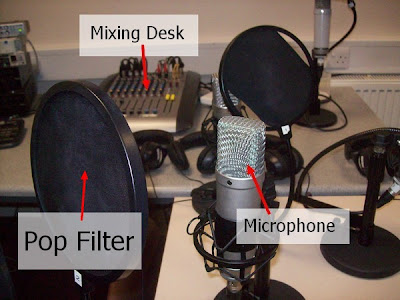Here are a few annotated diagrams of the cameras.
We used the tripod to prevent camera shake. The lens is the part of the camera which detects the images in front of it.
We didn't actually use the zoom button whilst recording, however in techniques such as foreshortening, we zoomed in prior to pressing record. The viewfinder shows us what the lens is processing.
The slots for the USB Cables allowed us to plug the camera directly into the computer to download all of our footage. The manual focus dial allowed us to manually adjust the focus of the shot. This was used in the 'Manual Focus Pull'. The record button, the round red one in the centre, tells the camera to begin capturing the images it sees.
This is a diagram of the microphone.
The microphone pics up the sound spoken into it. The pop filter eliminates 'popping' sounds caused by the impact of fast moving air on the microphone during recorded speech. The mixing desk allows us to control several microphones at once, for example in a group recording. However, we were just using the one microphone so we turned down all the other microphones.
We also used several programs to create our product.
Adobe Photoshop was used to create the logos for the media industries, as well as the title sequence.
Adobe Premier was used to edit the footage together. We also used it to add effects to the video, such as the lens flare for the gun shot, and the high contrast colour alteration for the flash back. We also learned how to add titles to our footage using Premier. The key frames allowed us to manipulate the movement of the titles, causing them to slowly move across the screen, fading in and out.
We decided not to use Adobe After Effects as we felt that the effects we could create on there were too dynamic for the style we wanted. We also felt that in the time we had, it was too complicated and the effects were unnecessary. The effects of Premier were sufficient for our needs.
We used Audacity to record the radio broadcast. We also used a function in Audacity to generate white noise, or static, which is heard in the broadcast.
We used SoundCloud to get sound effects such as the wind, the static, and the music which was played during the clip.
Finally, we posted our video on YouTube, an on-line video sharing website which allowed us to collect responses to our video, as well as the ability to distribute it.

















No comments:
Post a Comment